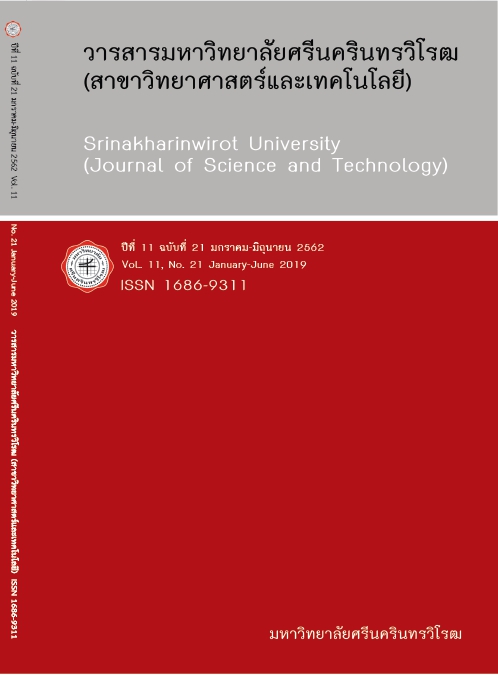การวิเคราะห์เปรียบเทียบความเค้นของฟันรักษาราก ที่มีขนาดคลองรากฟันกว้าง เมื่อใช้เดือยฟันเสริมเส้นใยจำนวนต่างๆ ด้วยวิธีไฟไนต์เอลิเมนต์ COMPARATIVE STUDY OF STRESS ANALYSIS OF ENDODONTICALLY TREATED TEETH WITH FLARED ROOT CANAL, RESTORED WITH DIFFERENT NUMBER OF FIBER POSTS BY FINITE ELEMENT METHOD
Keywords:
Finite Element Analysis, Endodontically Treated Tooth, Tensile Strength, Fiber Post, Composite ResinAbstract
Stress distribution in flared root canal with various restoration are investigated by 3D finite element analysis (SolidWorks). Human first mandibular single-root premolars was scaned by cone beam computed tomography to obtain the three dimension in order to create the model. The finite element model of premolar teeth are divided into 3 groups; group 1 was restored with a resin composite core material (Multicore Flow), group 2 was restored with a single fiber post and resin composite core (FRC Postec Plus no. 3, Multicore flow), and group 3 was restored with 3 fiber posts and resin composite core (1 FRC Postec Plus no. 3 and 2 fiber posts no. 0, Multicore flow). All models were loaded by the force 1000 newton at 45 degree to horizontal axis.
The analysis result of all tooth models showed the highest pricipal tensile stress concentrations in middle of the root. In addition, group 2 shows the lowest pricipal tensile stress while group 1 has the highest pricipal tensile stress. The fracture area in the real experimental is represented by the highest of the stress concentrations area in finite element analysis. Therefore, the lowest level of the pricipal tensile stress in group 2 means the strongest fracture resistance to compressive load. Moreover, factor of safety (FOS) of group 2 is more than group 1 almost 2 times.
Downloads
References
[2] Pramote Dechaumphai. (2007). Finite Element Method in Engineering. 4th ed. Bangkok: Chulalongkorn University Press.
[3] D. B. Burr. (2016, September). The Use of Finite Element Analysis to Estimate the Changing Strength of Bone Following Treatment for Osteoporosis. Osteoporosis International. 27(9): 2651-2654.
[4] S. Sinthaworn, U. Puengpaiboon, N. Warasetrattana; and S. Wanapaisarn. (2018). Estimation of Ultimate Tensile Strength of Dentin Using Finite Element Analysis from Endodontically Treated Tooth. IOP Conf. Series: Materials Science and Engineering 303 (2018) 012008doi:10.1088/1757-899X/303/1/012008.
[5] Reinhardt RA, Pao YC, Krejci RF. (1984). Periodontal Ligament Stresses in The Initiation of Occlusal Traumatism. J Periodntal Res. 19: 238-246.
[6] Asmussen E, Peutzfeldt A, Heitmann T. (1999). Stiffness, Elastic Limit, and Strength of Newer Types of Endodontic Posts. J Dent. 27: 275-278.
[7] Rees JS, Jagger DC. (2003). Abfraction Lesion Formation in Maxillary Incisor, Canine and Premolar: A Finite Element Study. Eur J Oral Sci. 111:149-154.
[8] Tay FR, Pashley DH. (2007, April). Monoblocks in Root Canals - A Hypothetical or A Tangible Goal. J Endod. 33(4): 391-398.
[9] Engineering ToolBox. (2008). Polymers - Physical Properties. June 17, 2019, from https://www.engineeringtoolbox.com/polymer-properties-d_1222.html
[10] Siriporn Arunpraditkul, Siranee Saengsanon; and Wilasinee Pakviwat. (2009). Fracture Resistance of Endodontically Treated Teeth: Three Walls versus Four Walls of Remaining Coronal Tooth Structure. Journal of Prosthdontics. 18(2009): 49-53.
[11] O.C. Zienkiewicz, R.L. Taylor; and David Fox. (2014). The Finite Element Method for Solid and Structural Mechanics. Seventh Edition. Oxford: Elsevier.
[12] Chaosuan Kanchanomai. (2009). Failure of Engineering Materials. Bangkok: Thammasat Press.
[13] Marcelo Giannini, Carlos Jose´ Soares, Ricardo Marins de Carvalho. (2004). Ultimate Tensile Strength of Tooth Structures. Dental Materials. 20: 322-329.
[14] Lu H, Lee YK, Oguri M, Powers JM. (2006). Properties of a Dental Resin Composite with a Spherical Inorganic Filler. Oper Dent. 31(6): 734-740.
[15] Siriporn Arunpraditkul. (2002). The Effect of Various Methods for Post and Core Restoration on Stress Distribution in Flared Root Canal : The Finite Element Method. Thesis, M.Sc. (Prosthodontics). Bangkok: Faculty of Dentistry, Chulalongkorn University.
Downloads
Published
How to Cite
Issue
Section
License
Srinakharinwirot University Journal of Sciences and Technology is licensed Under a Creative Commons Attribution-NonCommercial-NoDerivs 4.0 International (CC-BY-NC-ND 4.0) License, Unless Otherwise Stated. Please Read Journal Policies Page for More Information on Open Access, Copyright and Permissions.



